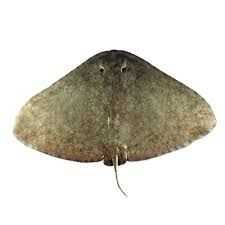Spiny Butterfly Ray

Species Details
Gymnura Altavela
Gymnuridae
Myliobatiformes
Inshore, offshore
115 - 130 lbs.
67" - 87"
Spiny Butterfly Ray (Gymnura altavela) Fish Description
The spiny butterfly ray, also known as the giant butterfly ray is a large, broad ray that can measure to over 6.7 ft. crosswise, with a lozenge-like shaped pectoral fin disk, as they are wider than they are long. They have concave front margins with rounded corners. They have short and blunt snouts, high cone-shaped teeth with around 98-138 rows on their upper jaw and 78-110 rows on their lower jaws. Within both their jaws, there are about 10-12 functional rows of teeth, with a dental band using 70% of the width of the jaw each. They have a short and slender tail, about a fourth of the width of the fin disk, with upper and lower fin folds.
The spiny butterfly ray can be distinguished from the Sympatric smooth butterfly ray by the Spiny Butterfly Rays base of its tail that has one or more serrated spines, and by a small tentacle-like structure on each inner posterior margin of the spiracle.
Their body's skin is considered to be naked while they are in their juvenile stages to sub-adults, with pale crossbars on their tails. But they develop patches of denticles on the center of their disk when reaching adulthood, with a dark brown color above their bodies, and every so often comes with small light or dark splotches and blotches in a sort of marbled pattern.
Diet and Size
Spiny Butterfly Rays diet primarily consists of fishes, such as leiognathus, small sharks, and squids, crustaceans, cephalopods, teleosts, gastropods. WIth teleost fishes becoming more and more essential to their diets with their increasing size.
Spiny Butterfly Rays are reported to grow up to the maximum length of 7.3 ft in width, in the Atlantic, but some unsubstantiated claims somewhere off West Africa have observed a ray up to 13ft. The maximum weight reported for the Spiny Butterfly Ray is weighed up to 130 lbs.
Interesting Facts about Spiny Butterfly Ray
- Spiny Butterfly Rays are active predators.
- When they approach a target, they usually move towards them slowly, before they quickly spin around and over it and strike them with one of their leading-edge pectoral fins.
- It is believed the reason for this action is to stun their prey before capturing them, as their pectoral fins have a high proportion of muscle and can deliver a strong blow.
- Spiny Butterfly Rays are harmless to humans.
- Some people mistake it for the Smooth Butterfly Ray.
- Check if it has a tentacle and a caudal fin spine. Those are the things that the Smooth Butterfly Ray doesn't have.
- Females usually stay in deeper waters but move to shallower waters to breed.
- Spiny Butterfly Rays are currently being raised in captivity. The first captive Spiny Butterfly Rays were born in August in AquaRio.
Spiny Butterfly Ray - Conservation status
Though the meat of the Spiny Butterfly Ray is well-regarded and caught for human consumption, it is not in the United States targeted by commercial fisheries and rarely are caught by-catch. The Spiny Butterfly Ray is currently considered to be a vulnerable species by the World Conservation Union.
Spiny Butterfly Ray ranging from elsewhere around the world faces a remarkable fishing pressure, including their coastal nursery areas, and has experienced a noted decline.
These species are considered to be Critically Endangered in areas such as the southwest Atlantic and the Mediterranean, where catches have drastically declined up to 99% due to fishing happening year-round. In West Africa, assess the species to be Vulnerable, as they have been taken either intentionally, or incidentally by the use of gillnets, trawls, longlines, and handlines.
Habitat and Distribution
Shiny Butterfly Rays can be found in shallow, brackish and coastal waters with sandy or muddy substrates, going at depths between 16-328 ft. They are considered uncommon overall, but possibly locally abundant in habitats suitable for them. Individual rays may be segregated by sex, with female Spiny Butterfly Rays preferring to stay in deeper ends of the water, but moving nearshore to spawn.
Spiny Butterfly Rays range is now considered to be quite patchy and has a discontinuous distribution in the Atlantic, within tropical and warm-temperate waters. They can be observed in the western Atlantic from Massachusetts, US to Buenos Aires Province in Argentina. They are a rare occurrence in the Gulf of Mexico but can be common enough in the mouth of tidal creeks located along the Virginia coast. And from the eastern Atlantic, they can be found from Portugal to Ambriz, Angola, including the Black Sea, Mediterranean Sea, and the Madeira and Canary Islands.







